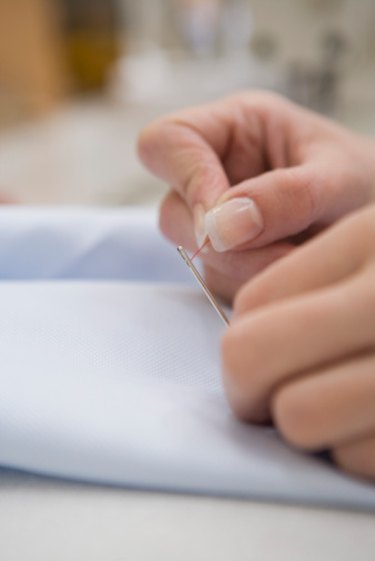
Use decorative stitching to dress up items such as pillowcases, knitted or crocheted items, cloth napkins or other sewing projects. Make decorative stitches with a sewing needle and embroidery thread to adorn fabric, or use a yarn needle and a contrasting color of yarn to embroider knitted or crocheted sweaters, hats, socks, mittens or other projects.
Edge Stitches
Video of the Day
Use decorative stitches along the edges of a fabric item to dress up the hem, or use decorative edge stitches to attach an applique flat atop a fabric item. Several edge stitch options exist, many of them variations on the traditional blanket stitch, which looks like a small "T" along the edge of a fabric piece. Variations of blanket stitch include crossed blanket stitch in which the "T" looks more like an "X" with a line across the top, gradual blanket stitch in which the stems of the "T"s are positioned at different heights and grouped blanket stitch in which blanket stitches are grouped closely together with spaced between groups.
Video of the Day
Non-Functional Stitches
Some decorative stitches worked on a fabric garment are merely there for adornment, and they don't actually serve a structural function for the garment. Such stitches include the herringbone stitch, which looks like a series of slanted "X"es across the work and the chevron stitch, which looks like a pattern of upside-down "V"s. These stitches are often worked with a thread that contrasts with the fabric so that they stand out as a decorative accent to the item.
Textural Effects
Create added texture to a fabric garment with decorative stitches that add texture to the item. For example, creating French knots, which are small balls of fabric used to decorate a garment or fabric item, give a bumpy texture and visual interest to an item. Similarly, seed stitch is also used to add a "raised" look and texture to a garment. Another textural effect is smocking, which involves manipulation of the fabric to create a texture while stitching.
Quilting
Quilting is decorative stitching used to sew through layers of fabric, typically a back layer, layer of batting and top layer. Quilting is done with a sewing machine or by hand, and the stitches themselves are typically very simple. The decorative element comes in with the design used for the quilting. A pattern can be drawn onto the fabric, and the stitching is done to follow the lines of the pattern.